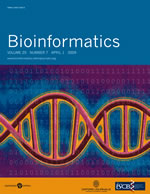
|
Bioinformatics Journal
At the time of writing our new 2009 impact factor has just been announced, and we’re happy to report that it has increased to 4,926. Some of the most highly cited papers contributing to this figure include:
We were very pleased to welcome David Posada to the Bioinformatics Associate Editor team at the start of 2010, bringing core expertise in the area of phylogenetics, and we have also been joined by three new editorial board members – welcome to Mario Albrecht, Predrag Radivojac and Cathal Seoighe. We’d like to take the opportunity to thank over 2800 individuals who acted as reviewers during 2009, making the peer review of over 2000 submissions possible. Online commenting functionality is now available to encourage comments and debate around the articles we publish. You might, for example, want to contribute your thoughts on Editorial pieces, or if you spot a dead link, the comments feature can be used to let readers know an up-to-date URL if the resource has simply moved location. Comments are moderated by the Editors prior to publication online to check appropriateness and prevent spam. Bioinformatics is again sponsoring the successful high-throughput sequencing (HiTSeq) SIG at ISMB this year and will award two prizes for the best papers during the event. Last year’s awards were presented to Kai Ye and co-authors for a paper on ‘Pindel’,and to Cole Trapnell and colleagues for ‘TopHat’. A selection of papers from HiTSeq 2010 appear in issue 10 of 2010, with the main conference proceedings of ISMB appearing in issue 12 and available open access. We’ll be handing out a printed collection of papers from our next generation sequencing virtual issue, which continues to grow online, at HiTSeq 2010 in Boston. Finally a quick update on our optional open access model – each Bioinformatics author has the choice of whether to publish under this model depending on the funds available to them. In 2009, 30% of authors chose the open access option - the highest uptake of all Oxford Journals participating in the optional Oxford Open initiative, and also we believe across the wider publishing landscape. Importantly the online subscription price for Bioinformatics is adjusted to reflect this level of uptake, so that authors and libraries do not pay twice for open access content. As always we welcome feedback on any aspect of the journal – please get in touch via the email address below. Best regards, Alex Bateman, Alfonso Valencia and the Bioinformatics Editorial team bioinformatics.editorialoffice@oxfordjournals.org |

